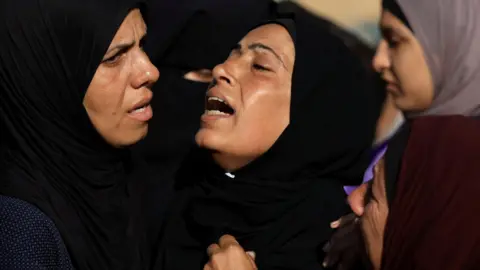In a tragic escalation of violence in Gaza, rescuers reported that eleven Palestinians, who were seeking aid, were killed by Israeli gunfire on Wednesday. This event occurred during a particularly devastating day, with at least 33 individuals losing their lives due to Israeli military actions across various locations in Gaza, according to local medics and rescue services.
The airborne assault was claimed by a spokesperson for the Hamas-operated civil defense agency, who stated that Israeli forces “opened fire and launched several shells” at crowds that had gathered along the main Salah al-Din Road, waiting in line for urgently needed food supplies. Eyewitness accounts and activists pointed to the extreme desperation experienced by the population, with images of people queuing for food portraying a somber reality in the Israeli-blockaded territory.
Israel’s military, however, described the incident differently, asserting that troops operating in the Nuseirat area had fired warning shots when a group approached them in a supposedly threatening manner. They claimed to be unaware of any resulting injuries. In addition to the 11 casualties from gunfire, another 19 people were reportedly killed due to three separate Israeli air strikes targeting various areas in southern and northern Gaza, including a tragic incident where eight individuals perished when a residential building was struck in the Zeitoun neighborhood of Gaza City.
The ongoing violence has amplified the cry for international attention to the humanitarian crisis unfolding in Gaza. Ghazans’ plight has intensified, with the Hamas-run health ministry reporting that at least 140 individuals had been killed in just the previous 24 hours alone. Among these were also reports of 51 lives lost while individuals awaited aid in Khan Younis, a southern district severely affected by the escalating conflict.
Compounding the thin veil of hope for humanitarian relief, sidelined initiatives led by the Gaza Humanitarian Foundation (GHF) have generated controversy. Existential debates underscored by a total Israeli blockade have led to lethal conditions where almost 400 individuals have been killed while attempting to secure aid since the GHF opened its first distribution center. The GHF’s measures have been criticized for bypassing traditional humanitarian protocols upheld by the United Nations and several other non-governmental organizations, with many viewing its actions as contrary to internationally accepted humanitarian standards.
The mounting desperation is evident; former residents have described the alarming scenes where aid seekers faced lethal fire amid their quest for basic necessities. A physician from al-Shifa Hospital noted stark realities as families bring in loved ones wounded by gunfire, instigated by the Israeli military, highlighting desperate narratives from the ground. One poignant account came from Umm Fida Masoud, whose son was injured in an event that became the tragic norm for many families in Gaza.
Adding to the dreadful atmosphere, a local journalist shared footage of his cousin celebrating after successfully obtaining a bag of flour. The small act of attaining basic sustenance, however, came cloaked in the echo of gunfire and the looming threat of military action. Reports from the World Food Programme indicated that only a fraction of the necessary food aid had reached the populace, with calls for a significant increase in distribution efforts underscoring the dire circumstances faced by Gazans.
Israel’s military operations, which have been framed as efforts to dismantle Hamas’s military capabilities, continue to exacerbate the situation. The Israeli government has often cited security concerns as justification for its actions, yet humanitarian advocates argue that these simply deepen the suffering of innocent civilians caught in the crossfire.
Amid these challenges, the head of the UN agency for Palestinian refugees has criticized the ongoing humanitarian frameworks, categorically condemning them as “lame, medieval, and lethal.” This assertion encapsulates the growing anger and the urgency for accountability regarding humanitarian provisions in conflict zones, emphasizing that international norms must be upheld in circumstances where the civilian populace is most vulnerable.
In the backdrop of violent confrontations, stories of everyday survival persist as both Gazans and foreign relief workers face insurmountable challenges to deliver and secure aid effectively. As Israel’s military campaign continues into its third month, the scars of conflict widen, ensnaring once-thriving communities in a quagmire of despair.



